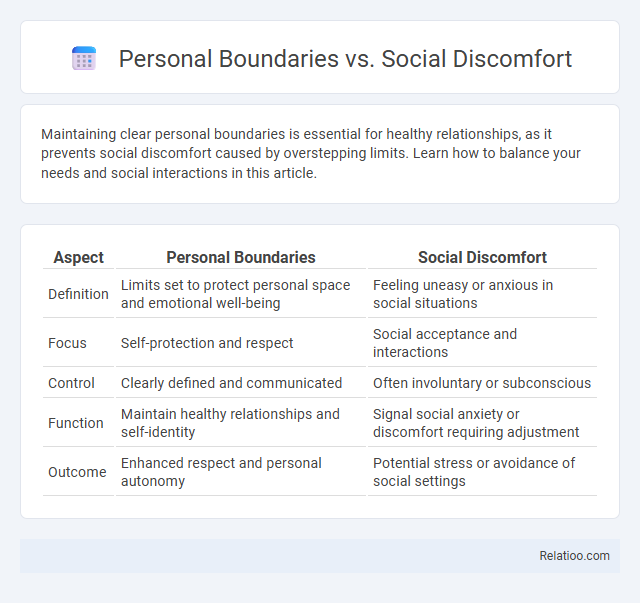Maintaining clear personal boundaries is essential for healthy relationships, as it prevents social discomfort caused by overstepping limits. Learn how to balance your needs and social interactions in this article.
Table of Comparison
| Aspect | Personal Boundaries | Social Discomfort |
|---|---|---|
| Definition | Limits set to protect personal space and emotional well-being | Feeling uneasy or anxious in social situations |
| Focus | Self-protection and respect | Social acceptance and interactions |
| Control | Clearly defined and communicated | Often involuntary or subconscious |
| Function | Maintain healthy relationships and self-identity | Signal social anxiety or discomfort requiring adjustment |
| Outcome | Enhanced respect and personal autonomy | Potential stress or avoidance of social settings |
Understanding Personal Boundaries
Understanding personal boundaries is essential for maintaining healthy relationships and self-respect by clearly defining what behaviors and interactions are acceptable. Personal boundaries help distinguish genuine discomfort caused by social situations from deeper emotional or psychological distress, allowing individuals to navigate social interactions more confidently. Recognizing and respecting these limits reduces social discomfort by preventing overexposure to stressors and fostering a sense of safety and control.
Defining Social Discomfort
Social discomfort arises when you feel uneasy or anxious in social situations due to perceived judgment, lack of familiarity, or fear of negative evaluation. Unlike personal boundaries, which are self-imposed limits to protect your emotional well-being, social discomfort often stems from external social dynamics and interpersonal interactions. Understanding the difference helps in managing your reactions and maintaining healthy relationships.
The Psychology Behind Boundaries
Personal boundaries are psychological limits individuals establish to protect their emotional well-being and maintain autonomy, differing from general social discomfort, which arises from unfamiliar or awkward social situations without necessarily implying boundary violations. The psychology behind boundaries involves understanding how intrusions on these limits trigger stress responses, leading to feelings of vulnerability or anxiety. Recognizing and respecting personal boundaries fosters healthier interpersonal relationships and reduces discomfort caused by perceived threats to one's sense of self.
How Social Norms Influence Discomfort
Social norms establish unwritten rules that shape personal boundaries by dictating acceptable behaviors within various social contexts, influencing how individuals perceive and respond to discomfort. When personal boundaries clash with prevailing social expectations, discomfort arises as a psychological response aimed at maintaining group cohesion and social harmony. Understanding the impact of cultural and societal norms on personal comfort levels reveals that social discomfort often serves as a mechanism enforcing conformity and regulating social interactions.
Signs Your Boundaries Are Being Crossed
Your personal boundaries are crossed when you experience persistent feelings of discomfort, anxiety, or resentment during social interactions without clear justification. Signs include feeling obligated to say yes, emotional exhaustion, and a loss of personal autonomy. Recognizing these indicators helps safeguard your well-being and maintain healthy relationships.
Navigating Social Discomfort Respectfully
Navigating social discomfort respectfully involves recognizing and honoring personal boundaries while being sensitive to others' feelings. Your ability to distinguish between personal boundaries and temporary social discomfort helps maintain healthy interactions and fosters mutual respect. Practicing empathy and clear communication reduces misunderstandings and promotes a positive social environment.
Balancing Assertiveness and Empathy
Balancing assertiveness and empathy is key to maintaining personal boundaries while navigating social discomfort and general discomfort. You can protect your own needs by clearly communicating limits without dismissing others' feelings, fostering mutual respect. Developing emotional intelligence helps identify when to stand firm and when to show understanding, creating harmonious interactions.
Strategies for Setting Healthy Boundaries
Setting healthy personal boundaries involves clearly identifying your own limits regarding emotional, physical, and digital interactions. Techniques include assertive communication, consistent reinforcement of limits, and self-awareness to differentiate between genuine social discomfort and boundary violations. Practicing mindfulness and seeking supportive environments enhance boundary maintenance while reducing anxiety associated with social discomfort and generalized discomfort.
Common Misconceptions About Boundaries
Personal boundaries are often mistaken for social discomfort, but they are distinct concepts; boundaries define your limits for respect and self-care, whereas social discomfort is an emotional response to social situations. Many people confuse feelings of unease with someone violating their personal space, which leads to misunderstandings about what constitutes healthy boundaries. Your clear understanding of this difference empowers you to maintain genuine connections while respecting your emotional needs without attributing every discomfort to boundary issues.
Building Comfortable Social Connections
Establishing personal boundaries is essential for building comfortable social connections, as it allows you to maintain your emotional well-being while engaging with others. Social discomfort often arises when boundaries are unclear or violated, underscoring the importance of clear communication to navigate interactions confidently. Recognizing and respecting your own limits helps reduce overall discomfort, fostering healthier and more authentic relationships.

Infographic: Personal Boundaries vs Social Discomfort
 relatioo.com
relatioo.com